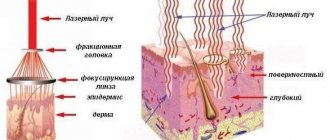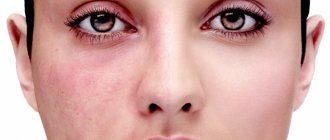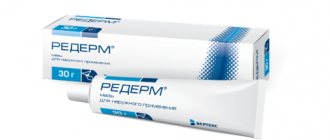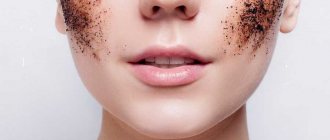My face looks like an orange peel: what should I do?
When “orange peel” appears, the question is how to remove unpleasant symptoms.
Many people try to disguise them using foundation. In fact, this tactic is highly undesirable, as it can lead to clogged pores and make the problem even worse.
If the skin on your face has become like an orange peel, you need to undergo a series of restorative cosmetic procedures as soon as possible. In this case, atraumatic facial cleansing, peeling and laser exposure are most effective.
Atraumatic facial cleansing
This procedure is a combination of soft dry cleaning and mechanical action. It allows you to eliminate acne, oily shine, inflammation, and activates regeneration processes.
Atraumatic facial cleansing has many advantages:
- visible result after the first session;
- no risk of skin damage;
- the ability to treat only problem areas.
The first stage of the procedure involves sequential application of masks with glycolic acid to the skin. However, since such an effect does not eliminate all impurities, it is combined with manual peeling.
At the end of the procedure, a mask is applied to help moisturize the skin and tighten pores. In total, the session lasts about half an hour.
Peelings
Peels allow you to get rid of enlarged pores, increased oiliness or excessive dryness of the skin, inflammatory processes and many other problems.
It is no coincidence that they are one of the most popular cosmetic procedures.
There are chemical, mechanical and hardware peels. The first are based on the influence of chemicals (usually acids), the second are based on manual application of drugs with active ingredients, and the third can be carried out using a laser or ultrasound.
Depending on the degree of impact, the following types of peeling are distinguished:
- surface;
- median;
- deep.
Maximum penetration into the skin layers allows for the most pronounced effect, but is accompanied by increased skin trauma. That is why such procedures should be carried out exclusively in the salon.
Laser
The effect of the laser also allows you to quickly eliminate the effect of orange peel on the face. This procedure is in great demand because it acts against a number of cosmetic defects:
- hyperpigmentation;
- wrinkles;
- striae;
- enlarged pores;
- acne and post-acne;
- rosacea;
- scars.
A positive result is noticeable after the first visit to the clinic, but usually experts recommend at least 2-3 sessions.
At Nomosclinic, this procedure is carried out using a reliable Italian Synchro Play DEKA device equipped with a cooling system. The cosmetologist can regulate the depth of its effect, ensuring a pronounced result without unwanted side effects.
More about procedures
Jessner Peel
Laser rejuvenation
Atraumatic cleaning
Oily skin
Oily facial skin: what to do?
There are 4 skin types. Among them, oily facial skin causes the greatest number of problems, since it is characterized by a number of negative signs. Most often, patient dissatisfaction is caused by such characteristic signs as greasy shine, the presence of enlarged pores, and comedones. In addition, it is with this option that the development of various inflammatory elements is most typical. Cosmetologists know best what to do in cases where oily skin causes concern. It is in their competence to clarify the situation and competently care for oily facial skin.
Causes of oily skin
Increased activity of the sebaceous glands leads to the appearance of excessive oily skin. The predisposing factors for this are the following:
- Heredity and individual characteristics;
- Endocrine disorders;
- Non-compliance with the diet;
- Disturbances in the functioning of the gastrointestinal tract;
- Incorrectly selected skin care, low quality cleansing procedures.
Skin type is not a constant value, and in the course of life it can change. Oily skin is more common in young people under the age of 25. In the future, in most cases, it transforms into a combined type. However, in cases where the main causes of oily facial skin are genetic, its clinical signs may persist throughout life. This development of the situation is observed in 5-7% of the population.
Hormonal imbalance is the factor that most influences the increase in oily skin. This process can develop both during puberty and with endocrine pathology. In women, the causes of oily facial skin in adulthood can be polycystic ovary syndrome, insufficient thyroid function, pregnancy, menopause, and uncontrolled use of oral contraceptives. Stress also contributes significantly to the development of symptoms.
Unbalanced functioning of the gastrointestinal tract, especially its manifestations such as constipation, is another prerequisite that affects the increase in oily skin. Poor nutrition, consumption of preservatives, fatty or spicy foods, easily digestible carbohydrates, as well as alcohol and carbonated drinks are also a negative factor.
Characteristics of oily skin
The quality of the skin and excessive oiliness appear unevenly in different areas of the face, which is due to the peculiar distribution of the sebaceous glands in its thickness. It is the accumulation of excretory ducts in certain places that explains the causes of oily skin on the forehead, nose and chin area. Characteristic areas are also located in the back or décolleté area. Often such negative signs are combined with oily hair. In women and men, these signs are usually expressed equally.
Typical manifestations of oily skin are oiliness and a greasy shine. It seems thickened. Excess sebum accumulating on the surface contributes to clogging of pores, their expansion, the formation of blackheads, comedones, and whiteheads, milia. Externally, oily skin on the forehead, nose and chin area resembles an orange peel.
Such signs have a negative effect not only on aesthetics. Oily skin of the forehead and other areas of the T-zone becomes the most preferred location for the localization of inflammatory elements, acne. This is explained by the fact that the narrow duct of the sebaceous gland and the production of an excess amount of secretion contribute to blockage of the excretory ducts of the glands, stagnation of secretion in it and infection. As a result, pustules with purulent contents appear. What to do if oily skin on the forehead is accompanied by the formation of pustular elements, a dermatologist will clarify. It is within his competence to prescribe treatment for acne. The services of a cosmetologist will be in demand only after the inflammatory process has subsided.
However, oily skin also has a number of positive signs. It is more capable of retaining moisture than dry. In this regard, its turgor remains at the same level. Much later, people with oily skin develop wrinkles.
Features of oily skin care
If your facial skin is very oily, a cosmetologist will most competently explain what to do and how to improve its quality. It should be taken into account that incorrect measures, even the use of exclusively external means, can aggravate the situation. The lack of a competent approach in this case may be ineffective or dangerous. You need to trust the professionals. A qualified cosmetologist will select appropriate facial skin care products. If additional procedures are needed to achieve the desired effect, he will carry them out competently. The doctor’s actions in this case should be aimed at reducing the production of sebum and removing its excess, cleansing the pores.
At home, this effect can be achieved by the following steps:
- Thorough cleansing of the skin using foam, gel or mousse for oily skin. To get the desired effect, it is recommended to carry out the procedure twice a day;
- Excluding actions that promote the activity of the sebaceous gland and the formation of excess sebum. These include frequent scrubbing procedures, the use of hot water and a washcloth for washing, the use of fatty cream, and alcohol-containing tonic;
- Normalization of the diet, excluding foods that have a negative impact on the quality of the skin.
An important step towards correcting existing deficiencies is to find out the causes of excess oily skin. In this regard, in addition to the measures prescribed by the cosmetologist, it would not be amiss to consult an endocrinologist and gastroenterologist. It is in their competence to give recommendations on what to do if oily facial skin is caused by concomitant diseases. In some cases, without appropriate treatment, it will not be possible to achieve a lasting improvement in the situation. The required result will be achieved only with an integrated approach.
Of great importance in the fight against the negative signs that accompany oily skin is the correct choice of cosmetic products for daily care. They should all be designed for oily skin, absorb quickly, leaving no shine. Preference is given to a delicate consistency and liquid structure.
In such a situation, it is recommended to scrub the skin 1-2 times a week. It would be optimal to use a film mask as a cleansing procedure, which will most carefully remove dead cells from the surface layer of the dermis. Masks with anti-inflammatory, sebum-regulating, and keratolytic properties are also recommended.
Cosmetologists define what to do if your facial skin is too oily:
- In addition to regular home care, salon cleansing procedures are recommended;
- It is necessary to adhere to the diet;
- Comprehensive examination by related specialists regarding concomitant pathology.
Salon treatments for oily skin
Salon treatments are more effective than care provided at home. By normalizing the functioning of the sebaceous glands, they can improve the quality of the skin and reduce its oiliness in a shorter time. In this case, experts recommend the following measures:
- professional care for oily skin;
- cleansing procedures, cleansing, peeling;
- hardware techniques, ultraphonophoresis, darsonvalization;
- injection procedures, mesotherapy, biorevitalization;
- facial massage, which, by improving microcirculation in the facial area, helps normalize the functioning of the sebaceous glands;
- cryomassage procedure aimed at narrowing pores.
Facial skin cleansing activities are carried out by using external products, applying a cleansing mask, as well as peeling and cleansing. In this case, depending on predisposing factors, ultrasonic, mechanical, and chemical facial cleansing can be used.
Despite the emergence of more innovative means, it is with the help of manual manipulation and a special spoon that it is often possible to get rid of all blackheads during one session. Other procedures, although less traumatic, do not allow obtaining such a quick and pronounced result. However, during mechanical cleaning it is possible that areas of hyperemia may appear, so before important events in the client’s life, specialists give preference to ultrasonic cleaning.
Among procedures aimed at eliminating excess oily skin, all-season peels are very popular. A special role is given to enzymatic peeling, the activity of which is ensured by enzymes. They destroy the substance that holds the horny scales, thereby promoting their independent exfoliation. The gentle effect and the absence of mechanical forces during the procedure ensure its safety and allow peeling not only in the salon, but also at home.
Here are a few questions that our clinic clients most often ask us.
Is it necessary to use moisturizer if you have oily skin?
Although oily skin loses moisture less rapidly than dry skin, it should also be hydrated.
A sufficient amount of hyaluronic acid, thermal water and other hydrofixatives in the composition of external products ensures the process of renewal of the epidermis. Thus, the necessary cleansing effect is achieved and the appearance of oily skin is reduced. How to deal with oily shine throughout the day?
In order to mask the greasy shine as efficiently as possible, you need to choose the right choice of both medicinal and decorative cosmetics.
Care products should be designed for oily skin and have a delicate texture. If possible, cleansing the skin should be done at least 2 times a day. Foundations and shadows should be powdery in nature with a mattifying effect. Creamy cosmetics will only emphasize the signs of oiliness. How to wipe your face if you have oily skin?
Cold water helps to tone oily skin and narrow pores, so some improvement can be achieved by rubbing the skin with ice cubes. The cosmetics industry is also replete with tonics designed for oily skin. The absence of alcohol in them eliminates the increase in the activity of the sebaceous gland. At the same time, they contain extracts of plant herbs that have a mattifying effect.
Cause of cellulite: pathogenesis and factors of occurrence
The pathogenesis of the phenomenon under consideration is complex. According to the hypothesis of Nurnberger and Muller, the origin of cellulite is explained by gender differences in the structure of the dermis of women. Structural changes in it (hypertrophy of subcutaneous fatty tissue, microcirculation disorders in tissues, compaction of connective tissue) lead to the formation of edema, tubercles, and looseness.
There are several factors that provoke such processes:
- Genetic predisposition;
- Excess weight;
- Hormonal imbalances;
- Pancreatic dysfunction;
- Diseases of the kidneys and adrenal glands;
- Pathologies of the urinary system;
- Depressive states;
- Tobacco smoking and addiction to alcoholic beverages;
- Poor nutrition;
- Lack of regular physical activity.
In order to choose the optimal method for treating cellulite, it is first recommended to consult an endocrinologist, gynecologist, and check the functioning of the abdominal organs and kidneys using ultrasound diagnostics.
How to fix the problem?
In order to eliminate the problem, it is necessary to improve skin tone, make it strong, elastic, and ensure normal moisture. In addition, you need to thoroughly clean the surface of dead cells and improve metabolic processes.
Depending on the main cause of the problem, a qualified cosmetologist at our clinic draws up one or another treatment plan that provides the desired result.
Zhmurina Natalya Borisovna
Director, Chief Physician of “A Clinic” Dermatovenerologist, cosmetologist
Stages of cellulite
It is customary to distinguish four stages of development of “orange peel” on the body:
- Stage 1 is the presence of excess fluid in the subcutaneous fat layer, which prevents its normal nutrition. This phenomenon is expressed only in a slight swelling of the tissues, which outwardly may look like mild swelling. The skin does not lose its smoothness and feels even to the touch.
- Stage 2 is characterized by increased swelling and the appearance of large amounts of fat in problem areas. Cellulite is only visible when muscles are tense.
- Stage 3 is characterized by the presence of noticeable bumps when the skin is pressed with fingers in areas with fatty deposits. This stage indicates that excess fluid is already deforming the surrounding tissues and causing circulatory problems.
- Stage 4 is the presence of a visible "orange peel" even when the skin is relaxed. Sometimes it may turn blue: this is a consequence of insufficient blood supply. When this stage is detected, treatment is necessary not only for aesthetic reasons, but also in order to eliminate the danger to health.
Why is this happening?
Skin pores are necessary for the processes of respiration, excretion, and thermoregulation.
Through them, the tubules of the sebaceous and sweat glands open. The reason for their expansion is the excessive function of the sebaceous glands, so this aesthetic defect is typical for oily or combination skin. As a rule, it occurs on the forehead, wings of the nose, chin, and less often on the cheeks. In adolescence, it causes acne. The causes of enlargement can be endocrine disorders (hormonal disorders), gastrointestinal problems, nervous disorders, stress, chronic constipation, weakened immunity, improper cosmetics, taking certain medications, poor diet, and excessive tanning.
Under the influence of ultraviolet rays, the production of collagen and elastin decreases, as a result of which the skin becomes flaccid and cannot counteract the expansion of pores.










